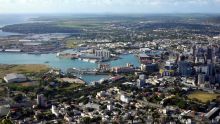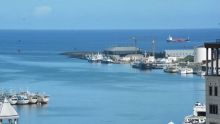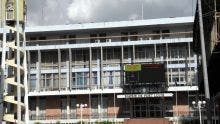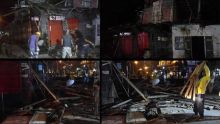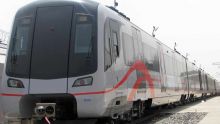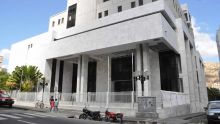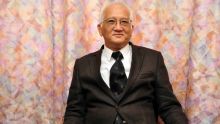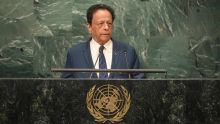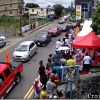Since last year, the government has been coming forward with projects to revisit the whole of Port-Louis. The main aim is to give a new look to the capital by 2020 and in so doing provide a new impetus to the economy. Four main areas of development include: revamping of the port facilities, setting up an internationally acclaimed cultural city, Port Louis Smart City and transfering all administrative centres to Ebene Heritage City. Infrastructural works will kick-start in 2016 spanning over five years. How will Port Louis look like in 2020?
[[{"type":"media","view_mode":"media_large","fid":"10155","attributes":{"class":"media-image wp-image-16194 aligncenter","typeof":"foaf:Image","style":"","width":"513","height":"308","alt":"PL FINAL-3"}}]] Rajiv Seervansingh: “Some of these projects are not feasible” The Assistant Secretary General of the Chamber of Commerce and Industry explains that there are two main components in what the Minister of Finance announced on the Port Louis 2020 project: revamping and re-development of Port Louis. “Of course, every Mauritian would be glad to see their capital city revamped. I believe that the projects announced by the Minister namely the expansion of the port, Port Louis smart city, cultural city and the relocation of administrative centres are extremely substantial but I doubt that they are feasible,” says Rajiv Seervansingh.
Port-Louis Smart City
Rs 52 billion will be invested to revamp the city of Port-Louis. The Port Louis Smart City consists of a series of projects to be driven by both the private sector and the government to meet the objectives set to elevate Mauritius and place it on the world map, and solve the many issues in the cultural, urban, economical and societal fabric. The plan presents an idea of cohesion and societal integrity that looks at a myriad of components as listed in this document. The series of independent projects in Ward IV, Champs de Mars, Plaine Verte, China Town, Aapravasi Ghat, the Water Front, and others as presented have for converging objective the increase in the livelihood of the populace and advocates for societal equity. The seven key drivers of the project are: Re-affirm Port-Louis’ Capital dimension; Re-connect with the sea; Connect the Heritage; Infuse Life; Tame mobility; Smart the City; and Celebrate the City. With this new development, 2,000 parking units will be created and 40% of decrease in Port-Louis traffic management will be achieved. It will also resolve the hawkers issue, create 8,000 residential units in the city as well as improve the quality of life for 191,000 voters.Heritage City
With the setting up of the Heritage City, the PMO and the Parliament will shift to Ebene. The identified site is spread over 336 acres of land situated in the south of Apollo Bramwell and Ebene. In a short video presentation, it has been explained that the National Assembly, the Prime Minister’s Office and eight major ministries will move there. New towers, described as “iconic buildings” will be built. Dubai will inject around $820 million in this project. Initially, the Mauritian State will not have to pay anything except a rental fee over a period of 20-25 years before the buildings become its property.An internationally acclaimed cultural city
By 2020, Port Louis will transform into an internationally acclaimed cultural city with new culturally active and vibrant structures. The city will thus promote new leisure and cultural offer for Mauritian as well as tourists. The aim is to showcase Port Louis as a model to be replicated by other towns and villages and to the African continent. The State Land Development Company has various projects aiming to convert the capital into a cultural city. Promenades will be created, starting from the Place d’Armes, passing by L’Intendance Streert, Jules Koenig Street, Pope Hennessy Street to the Champs-de-Mars. This promenade will have stalls dedicated to artists. The race course of Champs de Mars, which is traditionally used to host races on Saturdays, will contain an amusement park and a circus. Other historic sites should also be revamped. The SLDC also proposes to transform some paved pedestrian streets areas, including the portion located between the Royal Road and Sir William Newton Street. The city will thus be placed on the world map with the Louvre offer, the Aquarium and the Theme Park at Champ de Mars. China Town will be transformed into a “Cultural and Arts Free Zone” and the development potential of Aapravasi Ghat Buffet Zone will be unlocked (including the central market, among others).[[{"type":"media","view_mode":"media_large","fid":"10155","attributes":{"class":"media-image wp-image-16194 aligncenter","typeof":"foaf:Image","style":"","width":"513","height":"308","alt":"PL FINAL-3"}}]] Rajiv Seervansingh: “Some of these projects are not feasible” The Assistant Secretary General of the Chamber of Commerce and Industry explains that there are two main components in what the Minister of Finance announced on the Port Louis 2020 project: revamping and re-development of Port Louis. “Of course, every Mauritian would be glad to see their capital city revamped. I believe that the projects announced by the Minister namely the expansion of the port, Port Louis smart city, cultural city and the relocation of administrative centres are extremely substantial but I doubt that they are feasible,” says Rajiv Seervansingh.
[[{"type":"media","view_mode":"media_large","fid":"10156","attributes":{"class":"media-image size-medium wp-image-16192","typeof":"foaf:Image","style":"","width":"300","height":"199","alt":"Rajiv Seervansingh says that the government must come clean with the details on the realisation and implementation of the Port Louis 2020 project."}}]] Rajiv Seervansingh says that the government must come clean with the details on the realisation and implementation of the Port Louis 2020 project.<
/div>
According to him, the relocation of the administrative centres at the Heritage City of Highlands will have big geographical and commercial impact. “The relocation of the administrative centres will radically change the space use and structure in Port Louis as well as the overall geographical structure of the city will change. I trust that this relocation will raise lots of issues. Let us not forget that nearly half of the country’s working population commutes to Port Louis every day. The commercial activities of the capital city are highly dependant of this daily movement of people. The relocation of a majority of the administrative centres will definitely have a negative impact on those business activities.”
Regarding the port expansion project, Rajiv Seervansingh questions where will the Rs 52 billion come from in the next ten year to finance the project. “The Minister mentioned the private sector. We all know that the private sector usually expects pay back on its investment. I do not see where the pay back will come from. We thus need more clarifications for the port development project. The development and expansion project sounds very appealing and I believe that we can develop the port industry with a series of measures. However, we do not know who are going to invest in those projects. In addition, the concession demand of the Dubai Port for 75 years, who will invest in the project, is excessive. Concessions over 20 to 30 years are reasonable. I believe that a concession of 75 years is not feasible,” he argues.
Publicité
Port expansion
One of the objectives of the Port Louis 2020 project is to connect the city to the sea and enhance the seafront economic development potential. In September 2015, the Minister of Finance Vishnu Lutchmeenaraidoo was in Abu Dhabi to sign a Memorandum of Understanding (MoU) with Dubai Port World (DP World). The United Arab Emirates (UAE) will invest some Rs 50 billion in the Mauritian port. The port area will be expanded from Grand River North West to Baie du Tombeau. The port expansion will reposition Port Louis as an international and efficient conduit for international trade. This development is line with the strategic position of Mauritius in the South-South trade route. The expansion activities of the port includes extension of the berths at the Mauritius Container Terminal, refurbishment of three existing cranes, and the development of the Island Container Terminal. Port Louis has in fact a comparative advantage as a refuelling port (bunkering) in petroleum products transshipment port, home port or port of call for international cruise lines. The port development will thus provide better port facilities and improvement in productivity. It is thus expected to attract other shipowners to serve Mauritius, like the three main global shipping lines, namely MSC, Maersk and CMA CGM. Managed by the Mauritius Ports Authority (MPA), the port aims to become a regional hub for the world’s largest carriers. The port consists of two entities: the landlord and regulator by the Mauritius Ports Authority (MPA) and the operator that is the Cargo Handling Corporation Limited (CHCL). These are the two entities that are conducting the work expansion. They will last until March 2017 and will cost Rs 7.1 billion. The new Masterplan by the Mauritius Ports Authority will thus include the development of a full-fledged marina. Port Louis is the third deepest port of sub-Saharan Africa, with a draft of 14 meters currently. The existing wharf is 560 meters long. Once the expansion works are completed, the platform will reach a length of 800 meters. Once the dock will be enlarged, the port can simultaneously accommodate two wide body ships of 350m each. Its current capacity is 300m and another 175-200m ship. Dredging works will increase the draft to 16.5 meters. But long-term goals is to extend it to 18 meters.
Fabrice Annea: “That sounds too good to be true”
Architect Fabrice Annea claims that after listening to details of the transformation of Port-Louis into a Smart City, he questions the reliability of the project. “2,400 places reserved for street vendors, residences, wifi, culture and heritage, etc. Then private and foreign investors who will kindly help us. That sounds too good to be true! However, I am concerned about the future. This political development of territories seems to be worrying. It is good to be optimist but what about the outcomes of the project,” he says.
According to him, the population will not remain static and will continue to increase. Hence, there will be more demand in terms of jobs in various sectors like offices, shops and more hawkers around. “The proposed residences will not be accessible to everyone, so we can already predict societal and geographical segregation of social classes. The gap between the poor and the rich will continue to widen,” he says.
The Architect provides various examples of what did not work in various countries. “The history of architecture bears witness to the failure of such projects. The set up of these kinds of projects only create ghettos in the surroundings. Before the smart cities in France, there was talk of Ville Nouvelle which did not really work. Moreover, no consultation is done with the people,” he adds.
Fabrice Annea argues that the European Parliament defined a smart city as one which seeks to solve public problems through IT based solutions on municipal initiative partnerships and mobilising multiple stakeholders. “We need the opinions of experts like urban planners, sociologists and economists,” he states.

Notre service WhatsApp. Vous êtes témoins d`un événement d`actualité ou d`une scène insolite? Envoyez-nous vos photos ou vidéos sur le 5 259 82 00 !















